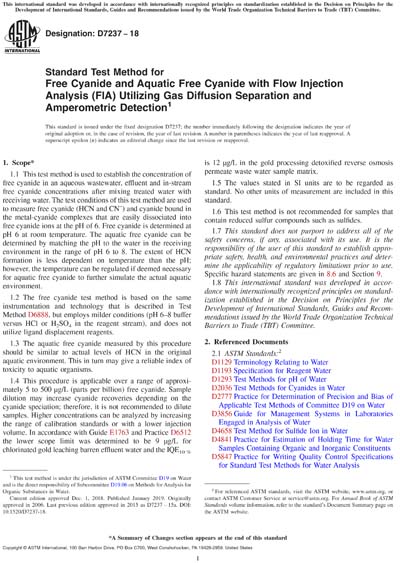Most recent
ASTM D7237-18
Standard Test Method for Free Cyanide and Aquatic Free Cyanide with Flow Injection Analysis (FIA) Utilizing Gas Diffusion Separation and Amperometric Detection
1.1 This test method is used to establish the concentration of free cyanide in an aqueous wastewater, effluent and in-stream free cyanide concentrations after mixing treated water with receiving water. The test conditions of this test method are used to measure free cyanide (HCN and CN–) and cyanide bound in the metal-cyanide complexes that are easily dissociated into free cyanide ions at the pH of 6. Free cyanide is determined at pH 6 at room temperature. The aquatic free cyanide can be determined by matching the pH to the water in the receiving environment in the range of pH 6 to 8. The extent of HCN formation is less dependent on temperature than the pH; however, the temperature can be regulated if deemed necessary for aquatic free cyanide to further simulate the actual aquatic environment.
1.2 The free cyanide test method is based on the same instrumentation and technology that is described in Test Method D6888, but employs milder conditions (pH 6–8 buffer versus HCl or H2SO4 in the reagent stream), and does not utilize ligand displacement reagents.
1.3 The aquatic free cyanide measured by this procedure should be similar to actual levels of HCN in the original aquatic environment. This in turn may give a reliable index of toxicity to aquatic organisms.
1.4 This procedure is applicable over a range of approximately 5 to 500 μg/L (parts per billion) free cyanide. Sample dilution may increase cyanide recoveries depending on the cyanide speciation; therefore, it is not recommended to dilute samples. Higher concentrations can be analyzed by increasing the range of calibration standards or with a lower injection volume. In accordance with Guide E1763 and Practice D6512 the lower scope limit was determined to be 9 μg/L for chlorinated gold leaching barren effluent water and the IQE10 % is 12 µg/L in the gold processing detoxified reverse osmosis permeate waste water sample matrix.
1.5 The values stated in SI units are to be regarded as standard. No other units of measurement are included in this standard.
1.6 This test method is not recommended for samples that contain reduced sulfur compounds such as sulfides.
1.7 This standard does not purport to address all of the safety concerns, if any, associated with its use. It is the responsibility of the user of this standard to establish appropriate safety, health, and environmental practices and determine the applicability of regulatory limitations prior to use. Specific hazard statements are given in 8.6 and Section 9.
1.8 This international standard was developed in accordance with internationally recognized principles on standardization established in the Decision on Principles for the Development of International Standards, Guides and Recommendations issued by the World Trade Organization Technical Barriers to Trade (TBT) Committee.
Content Provider
ASTM International [astm]






